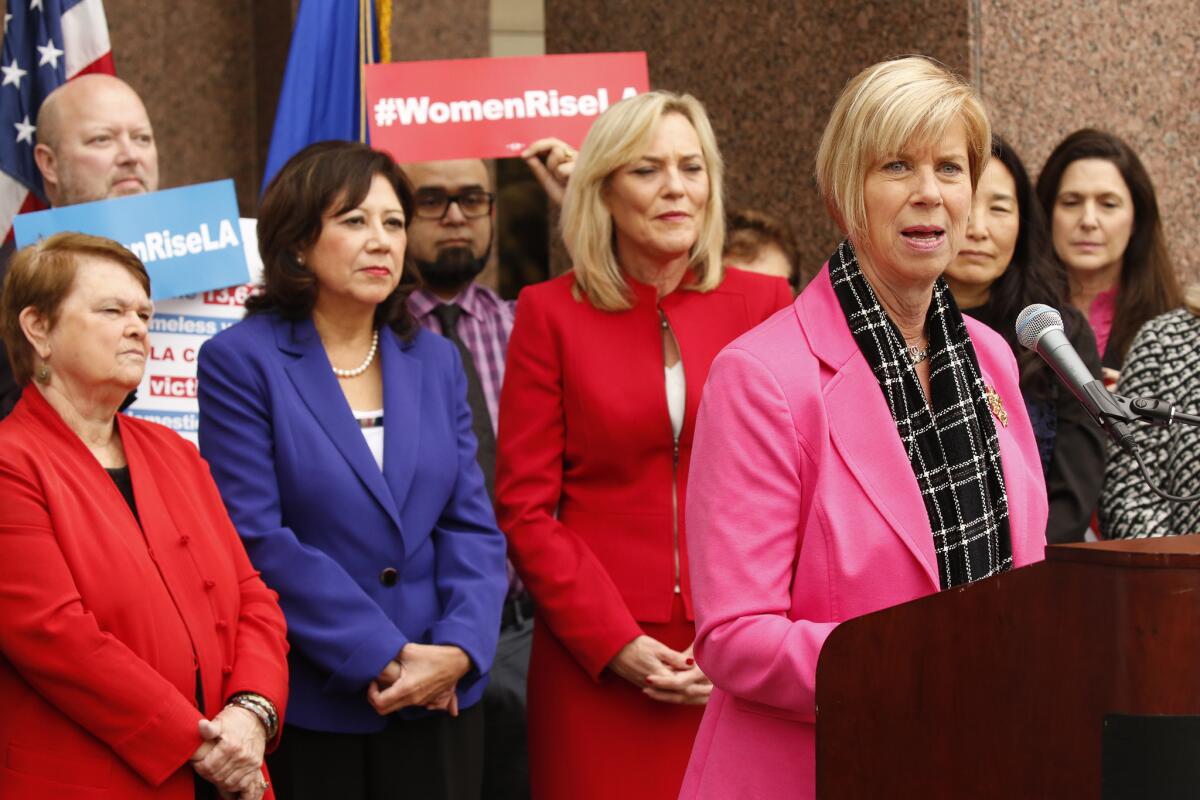Editorial: L.A. County has a plan to move away from jails and toward public health. What are we waiting for?

- Share via
A broad rethinking of the criminal justice system in Los Angeles began in earnest a year and a half ago when county supervisors heeded the demands of activists and dropped plans to open two new jails.
They may now need a reminder of what they accomplished — and how fruitless their work will be if they don’t push forward.
The supervisors’ 2019 pivot followed years of organizing by young advocates for fundamental change — people whose families and neighbors, or who themselves, had been injured and abused by a law enforcement system too focused on punishment and insufficiently directed toward healing, recovery and reconciliation. They presented their case to the supervisors, who after years of skepticism embraced the new vision.
Stopping jail construction was merely the beginning of the historic shift. What followed was a sometimes tense but remarkably productive year-long series of meetings at which community members, service providers, advocates and county officials hammered out proposals to create a health-based system that would direct people in crisis to mental health care, substance abuse treatment, housing, job training and peer counseling instead of arrest and incarceration.
In a historic vote, the Board of Supervisors adopted the resulting framework for a Care First, Jails Last program March 10, setting the stage for the county to hire a program director and craft a budget and implementation plan. But then the coronavirus intervened, shutting down California and shooting a $2-billion hole in the Los Angeles County budget.
The question before the supervisors now is whether to wait, hold tight to their money and shelve the Care First program until the day comes when the disease is vanquished, the recession is over and the budget is flush.
The answer must be an emphatic “no.” This is the time to move forward — swiftly and decisively.
This is the moment when jails have reduced their inmate populations because of the disease, and when a comprehensive effort is needed to ensure that those jails are not refilled with people who need not be there to protect public safety.
And this is the time, despite the budget emergency, when the county is deciding how to spend $1 billion in federal Coronavirus Aid, Relief, and Economic Security Act funding. There is money as well that previously had been allocated for one of the jails that was not built.
This too is the moment when national attention is focused on police abuse and institutional racism, and on demands to redirect funding for police and prisons to social services. Some cities are taking up that call, attempting to transfer money from police departments to social service programs. They are quickly discovering that real policy change takes time.
Advocates and service providers in Los Angeles County, however, have already successfully pressed the county to join with them in designing a comprehensive framework for moving forward. Most of these community members are the same ones protesting on the streets, demanding fundamental change to policing in Los Angeles. The Care First, Jails Last Alternatives to Incarceration program includes alternatives to policing and alternatives to prosecution, while also looking further than that, to the justice system as a whole.
Some building blocks for the Care First plan have already been operating successfully for several years, including the county Office of Diversion and Reentry, which provides care and housing in lieu of jail to people who qualify. Other elements of the plan are more recently established, such as the Office of Violence Prevention. The county has mobile psychiatric teams already responding to calls for help with mental health emergencies and partnering with sheriff and police departments when appropriate.
Soon to come: The county is moving forward swiftly on a behavioral health center on the Martin Luther King Jr. Medical Center campus and on a restorative care village for people in need of housing, psychiatric help, job training and other supportive services on the County-USC Medical Center campus.
But we need more — more capacity, more diversion, more healthcare. More commitment. More funding. We need outpatient clinics in more communities, peer-led rehabilitation and reentry services, and more county support for tried and tested but underfunded job-training and counseling programs.
We need L.A. County’s Care First, Jails Last Alternatives to Incarceration program moving forward, fully funded and at the top of the county’s agenda, fulfilling its fundamental task of serving people in need. This is the time when they will need it most, with disease rampant, the economy in shambles and competition for affordable housing fierce.
The plan will not by itself stop all crime, serve all psychiatric patients, house all homeless people, eradicate racism or end poverty. But it will be an powerful answer to the nationwide demand to rely less on policing and imprisonment and more on care to keep our communities safe. It can be the crucial next step toward doing the work that these five supervisors came here to do. It could be a model for the nation.
So supervisors, move forward. Hire an Alternatives to Incarceration director. Don’t miss this moment. It likely won’t come again in this generation.
More to Read
A cure for the common opinion
Get thought-provoking perspectives with our weekly newsletter.
You may occasionally receive promotional content from the Los Angeles Times.










